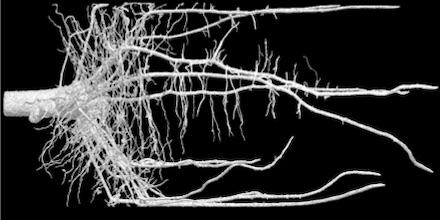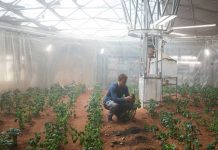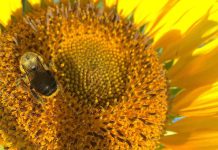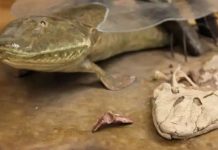
IMAGE: Researchers from the University of Kansas and University of Nottingham will use CT scanning to better understand the interplay between plants and soil microbes.
view more
Credit: Gabriel Castrillo
LAWRENCE — Just below ground, an ancient and poorly understood relationship plays out between plants and microbes that infuse the soil.
Now, with a three-year, $720,000 grant from the National Science Foundation, researchers from the University of Kansas and the University of Nottingham plan to investigate interactions between plants and the microbes on which they depend. In work that could inform agricultural practices around the world, the team will focus on how the relationship between plants and microbes respond to drought conditions.
“Microbes that live in the soil colonize the roots of the plants, and they can have big effects on plant growth and health,” said Maggie Wagner, assistant scientist with the Kansas Biological Survey and assistant professor of ecology & evolutionary biology at KU, who is primary investigator of the new grant. “We’re trying to figure out the effect of drought on that interaction. When you have plants that have to tolerate drought and soil microbes that have to tolerate drought — when those two partners come together, what’s the impact?”
Some microbes do require plant hosts, but researchers think the majority of plant-associated microbes also live free in the soil. Yet, plants are never without microbes. So Wagner will sequence the DNA of plants and plant microbes, and also “free living” soil microbiomes at various levels of drought stress. Her aim is to better pinpoint and understand genetic changes in a microbial community triggered by a shortage of water in the soil, as well as illuminate “genetic, physiological and ecological interdependencies” between microbes and plants.
“We’re going to actually force these microbes to evolve and adapt to drought in the lab using an experimental evolution set up, then we’re going to sequence them before and after the adaptations to figure out which microbial genes are involved in adaptation to drought stress,” Wagner said. “Then we’re going to take those microbial communities and give them to plants to try to measure what effect the communities have on the plants’ structure and metabolic activity and other traits that are important for surviving drought.”
While drought places stress on microbial communities in the soil, the KU researcher said sudden downpours can also tax microbes — conditions she hopes to replicate in her experiments.
“We’re planning to give the microbial communities about four months to adapt to their drought treatments, which is many, many microbial generations,” Wagner said. “We’re going to give the drought-treated microbes water every two weeks. The reason we give them water occasionally is because a lack of water is stressful — but once they’re in dry conditions and there’s a sudden rainfall event that introduces a lot of water, it also can be stressful to the microbes. It forces them to regulate their salt content and other things. So, we’re hitting them with water limitation and then suddenly rewetting to try to simulate what it’s like in nature.”
In addition to lab work, Wagner and her team will sample microbes and plants from across the state of Kansas, focusing on microbes’ interaction with corn, because corn is such a vital cash crop to the U.S. and the world.
“It’s convenient here in Kansas because our state has this natural precipitation gradient from east to west, which allows us to quickly access soil microbial communities that are adapted to various levels of drought,” Wagner said. “Part of the DNA sequencing is going to actually be done on-site at the farm and field sites where we’re going to be collecting these soil samples. There’s new sequencing technology that’s portable and can be hooked up to a laptop. We can actually take soil right there on the farm and get our sequences right then and there, which is pretty cool.”
Meanwhile, co-primary investigator Gabriel Castrillo of the University of Nottingham will perform scans of the root systems of corn plants and their microbiomes.
“He’ll be doing a variety of physiological scanning procedures, including CT scanning and laser ablation tomography,” Wagner said. “All of these are going to give us some really in-depth data about what these plants look like when they’re grown in microbial communities that are or are not adapted to drought. We’re trying to understand when a microbial community in the soil adapts to drought, what are the functional consequences for the plants and the plants’ ability to potentially withstand drought as well.”
Under the grant at KU, graduate research assistant Ceyda Kural will receive training in the lab and gene sequencing techniques used to analyze the soil microbes. The funds will also support employment for a full-time postdoctoral researcher.
Wagner said she wanted her results to benefit farmers and the agricultural industry as climate change hastens more frequent and severe droughts across the U.S. and the rest of the world.
“We definitely hope that our data will be useful for the folks who are very specifically trying to develop new technologies that could be used in agriculture to mitigate droughts,” she said. “Droughts are already a major problem for agriculture, and it’s expected to get a lot worse with climate change. Our projects are going to generate a lot of molecular data — for example, sequence data on both plants’ gene expression and microbial gene expression. We’ll be able to provide really detailed information about how plants and microbes interact with each other at the molecular level in the context of drought stress.”
Additionally, funds from the NSF grant will help enhance a mobile exhibition called “Microbes on the Move,” intended to educate the public about the diversity of microorganisms and their importance to ecosystems of all kinds.
“It’s a pop-up exhibit from the KU Natural History Museum that has been around for a few years,” Wagner said. “It’s all about microbes and the microbes in humans in particular, and various activities related to microbial ecology. So, the point of these activities is to introduce members of the public to the idea that microbes are all around us, they do all kinds of things, they’re very diverse — and not all microbes are bad. This museum exhibit is portable so we can reach members of the public who are farther away from museum exhibits like this. We can go into any town and set up in a community center or a public library and reach a lot of people we wouldn’t be able to reach otherwise. So, part of this grant is going to be expanding that project, specifically by translating the materials into Spanish. Ceyda is a Spanish speaker, and she’ll spearhead this effort to translate the materials, which will allow us to bring the exhibit to communities in southwestern and western Kansas that are predominantly Latino communities.”
###
TDnews














